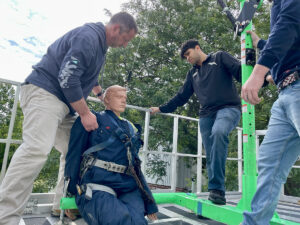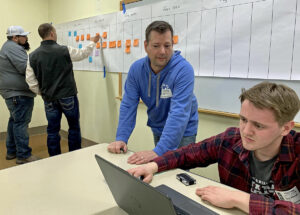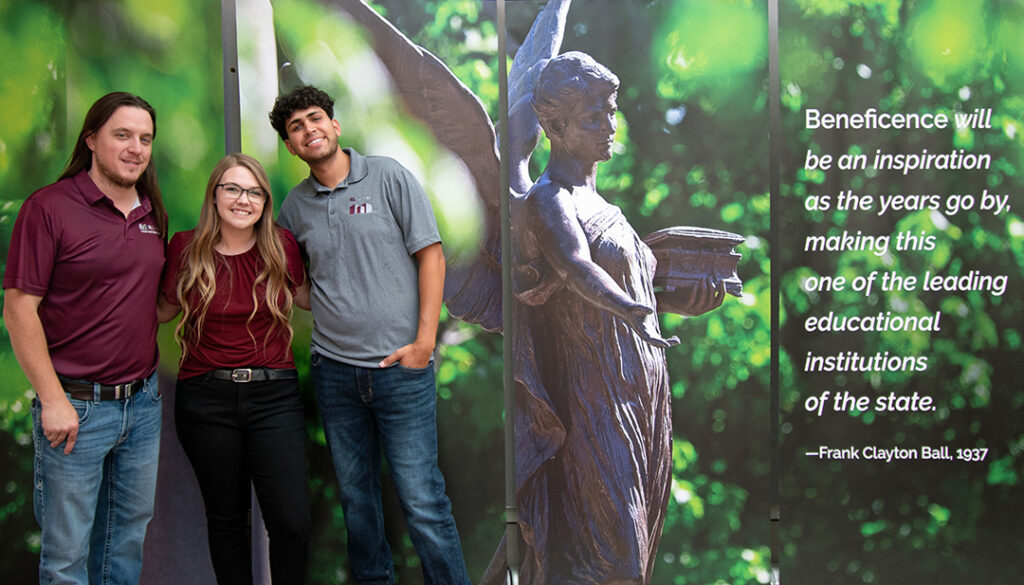By Layne Cameron
Nationally, the construction industry’s aging demographic and lack of female employees have been issues for decades. Recent graduates face the challenge of landing jobs, mastering menial tasks, and trying to prove themselves—all with many senior positions occupied by the old guard who are closer to retirement than their college days.
Obstacles notwithstanding, Ball State University’s Construction Management Program has seen record-high enrollment, with increases in minority and female students, as well as boasting of nearly 100 percent job placement over the last 14 years.
The fruit of the program’s efforts can be seen on campus career days. Construction management students must land two internships before graduating. So, it’s not uncommon to see many poised freshmen with polished resumes ready to compete for the best positions.
According to Jim Jones, chairperson of Construction Management and Interior Design, it helps to have strong Platinum Partners like RLTurner to help guide students’ career paths. “The construction industry is known for putting a lot of responsibility on graduates’ shoulders right away, and that can be a little overwhelming at times,” Jones says. “I’ve seen RLTurner baptize their new team members without letting them sink over their heads. They have built an all-Cardinal team to manage operations, and it is wonderful to see our alumni excel in this organization.”
It’s true that RLTurner’s entire project management team attended Ball State—and nearly half its entire office are Cardinals. Sure, numbers are great, but that’s not the whole story. The majority of RLTurner’s project managers are also recent graduates, a model that goes against industry standards. The company was restructured, so young employees have equal footing, rather than being employed in subservient capacity. When it comes to leading projects and making key decisions, it’s typically a Ball State alumnus under 30 who’s doing it.
Driving this effort is the company’s president, Adam Owens. He was one of Ball State’s first Construction Management graduates. He placed himself on a fast track at RLTurner, rocketing from intern to president in 11 years—by age 33. This, too, goes against the demographics of an aging construction industry.
Bigger Isn’t Always Better

Alumni Kevin Kendall teams with Youssef Mahfouz during a confined space training session.
Also bringing down the age demographic is Youssef Mahfouz. When he graduated in 2023, his first job was with Indiana’s largest construction company. “At the time, I thought it was an accomplishment to get a job offer from such a big company, so I accepted,” Youssef says. It didn’t take him long, though, before he realized he wasn’t thriving in a large corporate setting with sharply defined departments and reporting lines. After a short stint, he landed a position with RLTurner.
“On paper, it looks like a lateral move,” Youssef says. “But what I’m doing now is a huge jump in experience and responsibility.” At his previous position, his primary duties involved pushing plenty of paperwork, from RFIs to submittals, and many layers separated him from corporate leadership. At RLTurner, however, he’s essentially an assistant project manager, with daily access to the president. “We’re running meetings and coordinating projects with owners and subcontractors; basically, it’s the same title, but there’s many more opportunities to take on more responsibilities.”
Looking For Young Leaders
In high school, Carlie Stalnecker was captain of her softball, basketball, and volleyball teams, as well as student council president her senior year. Back then, as today, she was always looking for ways to do more. That inner drive pushed her to get everything she could from her Ball State experience. Carlie’s team traveled to Chicago and won the 2022 Associated Schools of Construction Concrete Competition. She not only graduated summa cum laude in 2023, but she also served as her program’s commencement speaker.
Her capacity to stand at the podium helps her manage her current workload. For example, one of her projects was behind schedule because of permitting issues. Behind the scenes, she met with her subcontractors to come up with a viable solution. Her implementation, however, differed from the sequencing that the owners wanted. “Even though our president and the owner’s reps were there, I was allowed to present and defend my proposal,” Carlie says. “It was uncomfortable, but we eventually found common ground and came up with a workable conclusion. We have a great relationship with these owners, so it was satisfying to work it out.”
Leading From Behind
With nearly 30 years at RLTurner, Jeff Pratt is one of the company’s senior project managers. He finds that guiding younger teammates from the back at the classroom works better than standing at the chalkboard. “You have to understand the sequencing and the management aspects, but you also have to have the respect of the craftspeople who are doing the work and overseeing the project on a daily basis,” Jeff says.
Since RLTurner self-performs much of their own work, their new employees can actually pick up a hammer or a broom and experience the work firsthand. In office or afield, Jeff encourages his team to dive in and ask questions. The preference is to provide guidelines and let his teammates define their own approach.
With plenty of work to go around, Jeff is quite comfortable with his younger teammates leading projects. “We’ll prosper together, and we’ll fail together,” Jeff says. “But it’s always as one team.”
Bringing New Ideas
A large project at Tipton Community Schools illustrates this point. It was a five-year, multi-phased project, and everyone’s voices needed to be heard. To accomplish this, a pull-planning meeting was scheduled before any shovel hit the ground.
The idea came from 2021 graduate Aaron Albright, though. Having all the prime contractors in a single room vying to place their tasks—written on post-it notes and stuck on a large wall calendar—created an exercise in courtesy in its own right, one that reflects the intricate ballet at the job site. It didn’t take long for everyone to see how each company’s work overlapped with others. A stack of multi-colored post-its dramatically illustrated the bottleneck that was guaranteed to happen if everyone wasn’t on the same page.

Jeff and Aaron pull planning.
Aaron and Jeff gathered everyone around the wall calendar and began talking. The post-it notes spread out, and the workflow snarl untangled. More importantly, it eliminated a job-site headache before it had a chance to fester, cause heartburn between contractors, and delay the project. “Identifying and addressing that issue easily saved us a month of delays,” Jeff says.
Aaron doesn’t fear bringing up new ideas like this. “I feel like I can come up with a creative decision, and I know that everyone has my back,” he says. “At my age, I don’t think many of my contemporaries outside of our company have that same experience.”
Creating Solutions, Not Problems
While some of his fellow classmates were starting jobs corralling submittals or conducting field observations, Sam Medlen played a key role in building West Lafayette’s Cason Family Park shortly after graduating in 2023.
With the park’s finish line in sight, a critical mistake cast a shadow on its success. One building’s floor was deemed unsuitable. “Since it was our mistake, we offered a solution first rather than let them find it and demand it be fixed,” Sam says.
Since many of RLTurner’s recent graduates shared classes at Ball State, the same Cardinal comradery continues in their professional lives. “Youssef and I share a wall between us, so it’s easy to talk through ideas,” Sam says. “It’s the same with all my coworkers; when an issue like the floor comes up, I know I can talk to them and come up with a solution.”
“The success our company has seen over the last several years proves that young leaders can bring a fresh perspective and propel an organization to new heights, while maintaining respect for the foundation it was built upon,” Adam says. “This is what RLTurner has been transforming into as an organization, and through a continued meaningful relationship with institutions like Ball State and its Construction Management Program, we will continue to push these boundaries for decades to come.”
